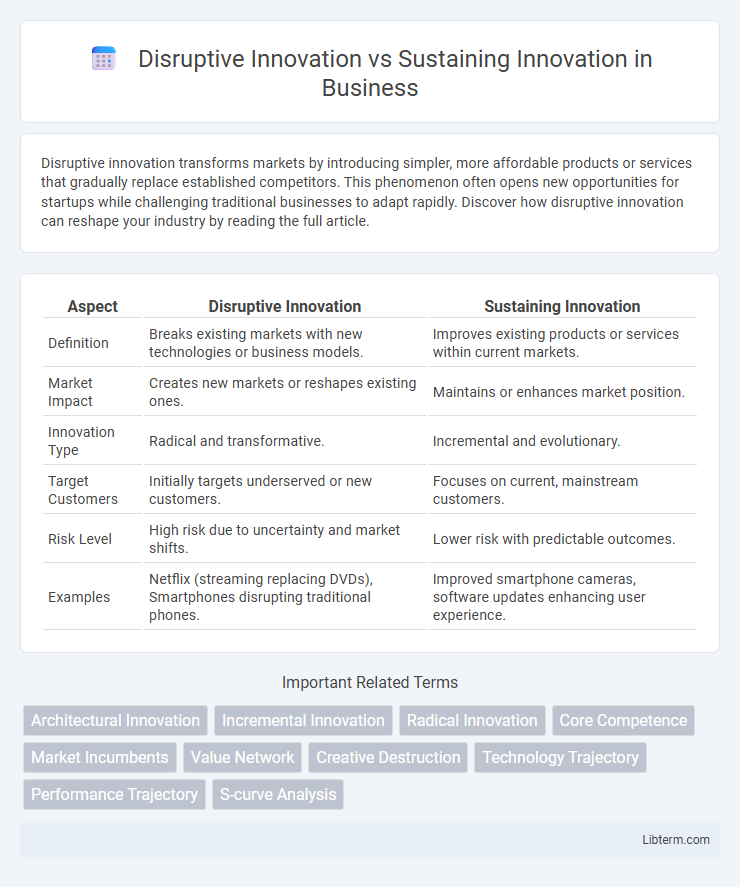Disruptive innovation transforms markets by introducing simpler, more affordable products or services that gradually replace established competitors. This phenomenon often opens new opportunities for startups while challenging traditional businesses to adapt rapidly. Discover how disruptive innovation can reshape your industry by reading the full article.
Table of Comparison
| Aspect | Disruptive Innovation | Sustaining Innovation |
|---|---|---|
| Definition | Breaks existing markets with new technologies or business models. | Improves existing products or services within current markets. |
| Market Impact | Creates new markets or reshapes existing ones. | Maintains or enhances market position. |
| Innovation Type | Radical and transformative. | Incremental and evolutionary. |
| Target Customers | Initially targets underserved or new customers. | Focuses on current, mainstream customers. |
| Risk Level | High risk due to uncertainty and market shifts. | Lower risk with predictable outcomes. |
| Examples | Netflix (streaming replacing DVDs), Smartphones disrupting traditional phones. | Improved smartphone cameras, software updates enhancing user experience. |
Understanding Disruptive Innovation
Disruptive innovation refers to technologies or business models that create new markets by initially targeting underserved or niche customer segments, eventually displacing established competitors. It often begins with simpler, more affordable solutions that improve over time, transforming industries and consumer behavior. Understanding this concept is crucial for businesses aiming to anticipate market shifts and capitalize on emerging opportunities.
Defining Sustaining Innovation
Sustaining innovation refers to incremental improvements made to existing products or services that enhance performance, maintain market competitiveness, and meet the evolving demands of current customers. Unlike disruptive innovation, which creates new markets by introducing groundbreaking technologies or business models, sustaining innovation focuses on refinement and optimization within established market frameworks. Companies investing in sustaining innovation aim to solidify their market position by consistently delivering better quality, increased efficiency, and enhanced features in their existing offerings.
Key Differences Between Disruptive and Sustaining Innovations
Disruptive innovation creates new markets by introducing groundbreaking products or services that initially target underserved or unserved customers, often displacing established competitors over time. Sustaining innovation improves existing products or services within established markets, focusing on incremental enhancements that meet the needs of current customers. Key differences lie in their market impact, with disruptive innovation driving market transformation and sustaining innovation emphasizing continuous improvement.
Historical Examples of Disruptive Innovation
The rise of the personal computer revolutionized computing by disrupting mainframe and minicomputer markets once dominated by IBM and traditional tech firms. Similarly, Netflix transformed the entertainment industry by shifting from DVD rentals to streaming, displacing conventional rental chains like Blockbuster. These historical examples of disruptive innovation highlight how new technologies create entirely new markets, ultimately redefining established industry landscapes.
Real-World Cases of Sustaining Innovation
Sustaining innovation enhances existing products or services, as demonstrated by Apple's iterative improvements in iPhone technology, maintaining its market dominance through refined features and performance upgrades. Toyota's continuous enhancement of hybrid technology in the Prius exemplifies sustaining innovation by improving fuel efficiency and reliability without disrupting existing markets. These real-world cases illustrate how sustaining innovation drives customer loyalty and incremental growth within established industries.
Impact on Industry Evolution
Disruptive innovation reshapes industry dynamics by introducing groundbreaking products or services that create new markets and displace established leaders, often targeting underserved customer segments. Sustaining innovation drives incremental improvements within existing frameworks, enhancing performance and maintaining competitive advantage for incumbent firms. The interplay between these innovation types accelerates industry evolution by balancing market expansion with ongoing refinement of core offerings.
Challenges in Adopting Disruptive Innovation
Challenges in adopting disruptive innovation include resistance to change from established market leaders and employees who are accustomed to sustaining innovations that improve existing products incrementally. Disruptive innovation often requires significant shifts in business models, resource allocation, and customer targeting, making it difficult for organizations to reorient their strategies effectively. Furthermore, the unpredictability of market adoption and potential cannibalization of current revenue streams create significant risk and hesitation in embracing disruptive technologies.
Strategic Approaches for Businesses
Disruptive innovation involves introducing groundbreaking products or services that create new markets and value networks, often displacing established competitors, while sustaining innovation focuses on enhancing existing products to maintain market position. Strategic approaches for businesses pursuing disruptive innovation emphasize agility, customer-centric experimentation, and investing in emerging technologies to capture untapped market segments. In contrast, sustaining innovation strategies prioritize incremental improvements, optimizing operational efficiency, and reinforcing brand loyalty to defend market share and drive steady growth.
Risks and Benefits of Each Innovation Type
Disruptive innovation introduces groundbreaking changes that create new markets or disrupt existing ones, offering high growth potential but carrying significant risks such as market uncertainty and organizational resistance. Sustaining innovation improves existing products or services, providing steady revenue growth and reduced risk by catering to established customers, though it may limit breakthrough opportunities. Balancing these innovation types is crucial for long-term competitive advantage and business resilience.
Future Trends in Innovation Dynamics
Future trends in innovation dynamics emphasize the increasing interplay between disruptive innovation, which radically transforms markets by introducing groundbreaking technologies, and sustaining innovation, which incrementally improves existing products and services to maintain competitive advantage. Advances in AI, quantum computing, and biotechnology are anticipated to drive new waves of disruptive innovations, reshaping industries such as healthcare, finance, and manufacturing, while sustaining innovations will continue to optimize operational efficiencies and user experiences. Organizations that strategically balance investment in both disruptive and sustaining innovations position themselves to adapt rapidly and capture emerging market opportunities in an evolving global economy.
Disruptive Innovation Infographic

 libterm.com
libterm.com